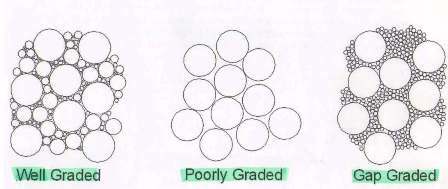
Today (NST)
Friday, Apr 25, 2025
Smart Search
Please post in your Technical Queries, Comments & Suggestions to Contact us......
Advertisement

For Advertisement
|
|
| Subscribe to BREINS Sci-Tech |
| Visit this group |

Concrete Technology
Gradation of Coarse
Aggregates
Coarse aggregates used in concrete making contain aggregates of various
sizes. This particle size distribution of the coarse aggregates is termed
as “Gradation”. The sieve analysis is conducted to determine this particle
size distribution.
Grading pattern is assessed by sieving a sample successively through all the sieves mounted one over the other in order of size, with larger sieve on the top. The material retained on each sieve after shaking represents the fraction of aggregate coarser than the sieve in question and finer than the sieve above.
Proper gradation of coarse aggregates is one of the most important factors in producing workable concrete. Proper gradation ensures that a sample of aggregates contains all standard fractions of aggregate in required proportion such that the sample contains minimum voids. A sample of the well graded aggregate containing minimum voids will require minimum paste to fill up the voids in the aggregates. Minimum paste means less quantity of cement and less quantity of water; leading to increased economy, higher strength, lower shrinkage & greater durability. The workability is improved when there is an excess of paste above that required to fill the voids in the sand, and also an excess of mortar (sand plus cement) above that required to fill the voids in the coarse aggregate because the fine material lubricates the larger particles.
Cement-paste or the “Matrix” that links together the coarse aggregates is weaker than the aggregates. It is this matrix that is vulnerable to all ills of concrete. It is more permeable and is susceptible to deterioration by the attack of aggressive chemicals. Therefore lesser the quantity of such weak link in concrete, the better will be the concrete. This objective can be achieved by having well graded aggregates.
As shown in Fig-2, there are three typical range categories of aggregate grading:
• Well graded : Well-graded aggregate has a gradation of particle size that fairly evenly spans the size from the finest to the coarsest. A slice of a core of well-graded aggregate concrete shows a packed field of many different particle sizes. It is characterized by the S- shaped in gradation curve.
• Poor graded : Poor-graded aggregate is characterized by small variation in size. It contains aggregate particles that are almost of the same size. This means that the particles pack together, leaving relatively large voids in the concrete. It is also called “uniform-graded”. It is characterized by steep curve.
• Gap graded : Gap-graded aggregate consists of aggregate particles in which some intermediate size particles are missing. A core slice of gap-graded, or skip grade, concrete shows a field of small sized- aggregate interspersed with slightly isolated, large aggregate pieces embedded in a small sized aggregate. It is characterized by a gradation curve with a hump in between.

Fig-2 : Gradation of Aggregates, showing, Well-graded, Poorly graded & Gap graded)
Poorly graded concretes generally require excessive amounts of cement paste to fill the voids making them uneconomical. Gap-graded concretes fall in between well-graded and poorly-graded in terms of performance and economy. Gap graded is viable gradation, but not optimal.
Well-graded aggregates are tricky in proportion. The goal of aggregate proportioning and sizing is to maximize the volume of aggregate in the concrete while preserving the strength, workability and finishing. This balance the proportions of each so there are just enough of each size to fill all the voids, while preserving workability and cast-surface quality.
Some experiments have concluded that grading for maximum density gives the highest strength, and that the grading curve of the best mixture resembles a parabola. However such aggregates graded to maximum density gives a harsh concrete that is very difficult in ordinary concreting. So the proportioning should be based on the surface area of aggregates that is to be wetted. Other things remaining same, it can be said that the concrete made from aggregate grading having least surface area will require least water which will consequently be the strongest.
Also it has been found that the surface area of the aggregates may vary widely without causing much appreciable difference in the concrete strength and that water required to produce a given consistency is dependent more on other characteristics of aggregate than on surface area. Therefore “fineness modulus” is also to be introduced for arriving at satisfactory grading. It was found that any gradation curve of aggregate that gives the same fineness modulus will require the same quantity of water to produce the mix of same plasticity and gives concrete of the same strength. Aggregates having two different gradings can have same fineness modulus. Fineness modulus is a measure of the degree of coarseness or fineness of an aggregate sample.